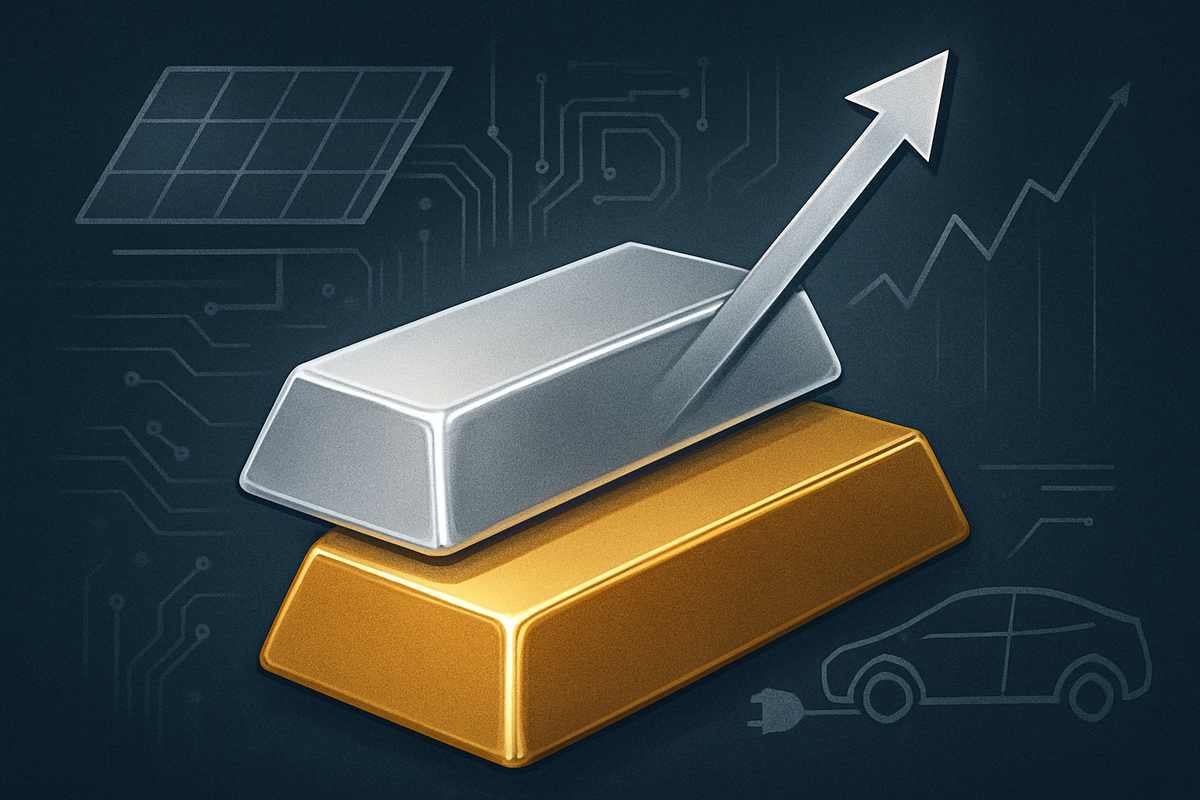
The financial markets are witnessing a remarkable shift in the precious metals landscape as the iShares Silver Trust (NYSE: SLV) demonstrates exceptional performance, with silver consistently outperforming its golden counterpart. As of November 28, 2025, SLV is trading robustly, reflecting a broader trend driven by silver's unique position as both a store of value and a critical industrial commodity. This surge signals a potential recalibration in investor portfolios, with silver emerging as a compelling asset class amidst evolving economic conditions and persistent inflation concerns.
This significant divergence in performance has immediate implications for investors and market participants. The sustained rally in silver, coupled with its industrial demand drivers, suggests a growing confidence in sectors like green energy and electric vehicles, where silver plays a crucial role. For those seeking hedges against economic uncertainty and inflation, silver's current trajectory offers an attractive alternative or complement to traditional gold holdings, prompting a deeper look into its long-term potential and market dynamics.
Silver's Ascent: A Detailed Look at the Record-Breaking Rally
The iShares Silver Trust (NYSE: SLV) has been at the forefront of a historic rally in the silver market, culminating in the precious metal reaching an unprecedented all-time high of over $55 per ounce on November 28, 2025. This remarkable surge reflects a complex interplay of persistent supply deficits, escalating industrial demand, and a renewed appetite from investors seeking both a safe-haven asset and exposure to burgeoning technological sectors. SLV, designed to mirror the price performance of silver, has seen its year-to-date (YTD) total return climb to approximately 74.55% as of late November 2025, with its price increasing by an impressive 83.82%. This far outpaces gold's YTD gains and significantly overshadows the S&P 500's performance, marking a definitive period of silver supremacy.
The timeline leading to this moment reveals a sustained build-up of bullish factors. Since 2020, the silver market has grappled with a cumulative supply deficit exceeding 800 million ounces, equivalent to nearly a full year of global mine production. Industrial demand, particularly from sectors like solar photovoltaics, electronics, and electric vehicles (EVs), has consistently risen, acting as a crucial underpinning for prices. Despite a forecasted 2% decline in overall industrial demand for 2025 due to global economic uncertainty, gains in AI-driven data centers and EV sales partially offset this. Key events in 2025 further fueled the rally: silver's price reached a 13-year high in June, the US government officially designated silver as a critical mineral in August, and October saw repeated tests of record highs, with silver touching US$54.48 per ounce. The dramatic climax on November 28 saw silver bullion break above $55 per ounce in London, hitting a peak of $55.30, amidst substantial inflows into SLV, requiring an additional 324 tonnes of silver. This occurred even as trading on New York's Comex futures and options temporarily re-opened after a technical problem at the CME Group, highlighting the intense market activity.
Key players and stakeholders in this unfolding narrative include the iShares Silver Trust (NYSE: SLV) itself, sponsored by iShares Delaware Trust Sponsor LLC, an indirect subsidiary of BlackRock, Inc. The trust's custodian, JPMorgan Chase Bank N.A., holds a significant portion of its bullion backing. Institutional investors such as Susquehanna International Group, Jane Street Group, and Citadel Advisors are among the numerous entities with substantial holdings in SLV, indicating broad professional interest. Retail investors, particularly in regions like the US, India, and Germany, have also played a vital role, driving physical silver demand. On the supply side, major mining companies like Fresnillo plc (LON:FRES), Industrias Penoles, and Pan American Silver Corp. (NYSE: PAAS) are central, with Mexico remaining the top silver-producing country. Market regulators and exchanges like the CME Group (Comex) and the London Bullion Market Association (LBMA) are critical for pricing and trading, while organizations like The Silver Institute provide essential market analysis.
Initial market reactions have been characterized by heightened volatility, particularly evident during the CME Group's technical disruption. However, overall sentiment remains overwhelmingly bullish, with expectations of continued upside driven by tightening physical supplies and anticipation of further monetary easing from the Federal Reserve. The gold-to-silver ratio, which fell below 76 on November 28, 2025, for the first time in nearly 18 months, underscores silver's relative strength and suggests a correction of its historical undervaluation compared to gold. The market has also seen a significant liquidity squeeze and tight physical supply, with lease rates for silver surging and inventories in LBMA vaults and Chinese holdings reaching multi-year lows, all signaling a robust demand environment outstripping available supply.
Corporate Fortunes in Flux: Winners and Losers in Silver's Rally
The surging price of silver, underscored by the robust performance of the iShares Silver Trust (NYSE: SLV) and its outperformance against gold, is creating a clear divide between corporate winners and losers across various sectors. Companies directly involved in silver extraction and investment are poised for significant gains, while industries heavily reliant on silver as a raw material face escalating costs and potential margin pressures.
Leading the charge among the beneficiaries are silver mining and streaming companies. Higher silver prices translate directly into increased revenues and enhanced profit margins for these entities. Pan American Silver Corp. (NYSE: PAAS), a prominent global silver producer, stands to gain substantially, especially after expanding its portfolio through strategic acquisitions. Similarly, First Majestic Silver Corp. (NYSE: AG), with its primary focus on silver production and mines predominantly in Mexico, is well-positioned to capitalize on the rally, further bolstered by its direct-to-consumer minting operations. Other key winners include Hecla Mining Company (NYSE: HL), one of the largest U.S. silver producers, and Fresnillo plc (LON:FRES), the world's largest primary silver producer, both boasting strong operational bases to leverage the price surge. Streaming and royalty companies like Wheaton Precious Metals Corp. (NYSE: WPM) also benefit immensely. By providing upfront financing to miners in exchange for future silver at fixed, low prices, Wheaton's model allows it to convert rising spot prices directly into higher profits without incurring the direct operational risks of mining. Naturally, investors holding shares in the iShares Silver Trust (NYSE: SLV) are direct beneficiaries, as the ETF's value is intrinsically tied to the physical price of silver bullion.
Conversely, industries with significant silver consumption as a raw material are bracing for increased operational costs. Solar panel manufacturers, where silver is a critical component in photovoltaic cells, are particularly vulnerable. Companies such as First Solar (NASDAQ: FSLR) and Canadian Solar Inc. (NASDAQ: CSIQ) will face heightened production expenses. Silver's share of solar module production costs has notably surged, exacerbating competitive pressures within the industry and prompting exploration of costly alternatives like copper. Electronics manufacturers, including giants like Apple (NASDAQ: AAPL) and Samsung (KRX:005930), will also contend with higher material costs for the silver used in printed circuit boards, connectors, and 5G components. These companies face the dilemma of absorbing these increased costs, thereby impacting profit margins, or passing them on to consumers, which could potentially dampen demand.
The automotive industry, particularly electric vehicle (EV) manufacturers such as Tesla (NASDAQ: TSLA), General Motors (NYSE: GM), and Ford (NYSE: F), will also feel the pinch. EVs utilize significantly more silver than traditional internal combustion engine vehicles due to their complex electrical systems and battery management components, meaning higher silver prices directly inflate manufacturing costs. Lastly, jewelry manufacturers and retailers, including luxury brands like Tiffany & Co. (owned by LVMH Moët Hennessy Louis Vuitton SE - LVMH) and Signet Jewelers Limited (NYSE: SIG), will experience increased raw material costs. As silver jewelry is often marketed as an affordable alternative to gold, rising prices could lead to reduced consumer demand and squeezed profit margins, with some reports suggesting retail price increases of 100% or more in the near future.
Beyond the Bullion: Silver's Broader Economic and Industrial Resonance
The spectacular rally in silver, mirrored by the robust performance of the iShares Silver Trust (NYSE: SLV) and its continued outperformance against gold, carries a wider significance that transcends mere commodity price movements. This event is a powerful indicator of several converging macroeconomic and industrial trends, signaling profound ripple effects across diverse sectors and potentially inviting new regulatory considerations, all while echoing historical patterns of silver's unique market behavior.
At its core, silver's ascent in late 2025 is deeply embedded in the accelerating global green energy transition. With industrial applications now accounting for well over half of total silver demand, the metal's role has fundamentally shifted from primarily a monetary asset to a critical industrial input. Its unparalleled electrical and thermal conductivity makes it indispensable in solar photovoltaic (PV) cells, electric vehicle (EV) charging infrastructure, and a myriad of other high-tech applications. As nations worldwide commit to net-zero carbon goals, the demand for silver from these burgeoning sectors is projected to continue its aggressive growth trajectory. This trend, coupled with persistent supply deficits—now entering its fifth consecutive year in 2025 due to declining ore grades and silver's byproduct status in other metal mining—creates a powerful fundamental imbalance that underpins its current price strength. Furthermore, silver continues to act as a potent hedge against the inflationary pressures and global economic volatility that characterize the current macroeconomic environment, with expectations of looser monetary policies from central banks like the Federal Reserve further enhancing its appeal as a non-yielding asset.
The ripple effects of silver's rally are far-reaching. For competitors, particularly gold, silver's outperformance reinforces a bullish sentiment across the entire precious metals complex, though silver's industrial component gives it an "extra edge." Historically, silver tends to significantly outperform gold in the middle to later stages of precious metals bull markets, often delivering two to three times the percentage gains. This dynamic could lead to a reallocation of capital from traditional financial assets into precious metals, potentially impacting bond and equity markets. Partners in the supply chain, from mining companies like Fresnillo plc (LON:FRES) and Pan American Silver Corp. (NYSE: PAAS) to precious metals refiners, stand to benefit from increased profitability and demand. Conversely, industries heavily reliant on silver as a raw material, such as solar panel manufacturers like First Solar (NASDAQ: FSLR), electronics giants like Apple (NASDAQ: AAPL), and major EV producers such as Tesla (NASDAQ: TSLA), face the challenge of significantly higher production costs, which could compress margins or necessitate price increases for end consumers.
Regulatory and policy implications are also emerging. Silver's designation as a "critical mineral" by the U.S. and other nations could lead to supportive policies, including potential tariffs, government stockpiling, and export controls aimed at securing strategic reserves, which could further tighten global supply. Discussions around restructuring tariff rates on imported precious metals and environmental tariffs on mining operations are also anticipated, potentially reshaping global sourcing strategies. Given silver's relatively smaller market size, its current rally might also attract renewed scrutiny from regulatory bodies regarding potential market manipulation, particularly concerning outsized short positions. Historically, silver has demonstrated a consistent "lag-and-outperform" pattern relative to gold. Periods of a high gold-silver ratio (e.g., above 80:1) have often preceded significant silver rallies, as seen in the 1970s, the 2003-2011 bull market, and following the 2008 financial crisis and the March 2020 COVID-19 market turmoil. This historical precedent suggests that the current outperformance is not an anomaly but rather a characteristic behavior of silver in a bullish precious metals environment.
The Road Ahead: Navigating Silver's Future Trajectory
The current ascendancy of silver, epitomized by the robust performance of the iShares Silver Trust (NYSE: SLV) and its sustained outperformance against gold, sets the stage for a dynamic and potentially transformative period for the precious metal. Looking ahead from November 28, 2025, both short-term and long-term possibilities point towards a continued bullish trend, albeit with inherent volatility and strategic considerations for investors and industries alike.
In the short term, spanning the next 6-12 months, silver is widely expected to maintain its upward momentum. Forecasts from leading financial institutions like Citigroup and Bank of America suggest prices could consolidate within the $40-$60 per ounce range, with some projections reaching as high as $70+ by late 2026. This immediate strength is underpinned by the relentless growth in industrial demand, particularly from the photovoltaic (PV) solar and electric vehicle (EV) sectors, which collectively account for over half of global silver consumption. Anticipated easing cycles from major central banks, including the Federal Reserve, are expected to lead to lower real yields, further enhancing silver's appeal as a non-yielding asset. Moreover, the persistent structural supply deficits, marking the fifth consecutive year of demand outstripping supply, will continue to exert upward pressure on prices. SLV, as a direct reflection of physical silver prices, is poised to track these gains, with continued strong ETF inflows signaling sustained investor interest.
The long-term outlook for silver, extending to 2030 and beyond, is overwhelmingly bullish, with significant potential for substantial price appreciation. Projections range from $99 per ounce by 2030 by CoinPriceForecast to more aggressive scenarios exceeding $200 per ounce by the same year, driven by what some term "green demand spikes." The global push for renewable energy and electric vehicles will remain a fundamental driver, with solar alone potentially absorbing 15-20% of annual silver production by 2030. Structural deficits are expected to persist or even widen, as mine production struggles to keep pace with surging demand. Adding a new layer of support, some central banks are beginning to diversify their reserves to include silver, a trend that could provide significant long-term structural demand. For investors, strategic adaptations may include a diversified approach combining physical silver, silver ETFs like SLV, and shares in silver mining companies. Vigilant monitoring of ETF flows, COMEX/LBMA inventories, real yields, and industrial demand trends will be crucial for navigating silver's characteristic volatility.
Potential market opportunities abound, stemming from the explosive industrial demand driven by the green energy transition, persistent supply deficits, and supportive macroeconomic tailwinds. The current high gold-to-silver ratio also presents an opportunity for silver to significantly close the gap, potentially normalizing towards historical averages and driving further price gains. However, challenges persist, primarily silver's inherent volatility, which necessitates careful risk management. A strong resurgence in the U.S. dollar or an unexpected reversal of central bank easing policies could dampen enthusiasm, as could a significant global economic slowdown impacting industrial demand. Concerns about market manipulation, though addressed by past regulatory actions, remain a latent risk. Potential scenarios range from a base case of consolidation and structural upside, with silver averaging $45-$60 in 2026 and trending higher, to a bullish scenario where prices surge above $70-$100 into 2026-2027, possibly reaching $120 per ounce or more in a peak scenario. A less likely bear case, triggered by heavy speculative unwinding or a significant global downturn, could see a pullback to the $25-$40 range before recovery.
The Silver Standard: A Market Reassessment and Future Outlook
The remarkable performance of silver throughout 2025, culminating in its significant outperformance against gold and the robust rally of the iShares Silver Trust (NYSE: SLV), signals a pivotal moment in the precious metals market. This period is defined by a powerful convergence of fundamental demand drivers, persistent supply constraints, and a supportive macroeconomic landscape, prompting a re-evaluation of silver's intrinsic value and its role in diversified investment portfolios.
Key takeaways from this extraordinary rally highlight silver's dual identity as both a critical industrial commodity and a traditional safe-haven asset. Soaring industrial demand from the burgeoning green tech sectors—solar energy, electric vehicles, and advanced electronics—has become a primary engine for its growth, with industrial applications now accounting for over half of global consumption. This structural demand is further amplified by persistent supply deficits, marking the fifth consecutive year that mine output has struggled to meet escalating needs. Simultaneously, robust investment demand, evidenced by significant capital inflows into silver ETFs like SLV and increased physical bullion buying, underscores growing investor confidence amidst macroeconomic tailwinds such as anticipated Federal Reserve rate cuts, a weaker U.S. dollar, and persistent inflation concerns. The compression of the gold-silver ratio also suggests that silver, historically undervalued, is undergoing a significant re-rating.
Moving forward, the market outlook for silver and SLV remains largely bullish into 2026 and beyond. While some analysts anticipate a potential peak in 2026, many financial institutions have revised their price targets upwards, with forecasts ranging from $42 to $60 per ounce through mid-2026, and more optimistic projections reaching $70, $75, or even $90 by the end of 2026. The accelerating pace of activity in green tech industries is expected to further strengthen industrial demand, ensuring that supply deficits will likely persist. However, investors should also prepare for silver's characteristic volatility, acknowledging that potential pullbacks are a natural part of its price trajectory.
The lasting significance of this rally extends beyond mere price appreciation; it represents a structural shift in global financial dynamics, where precious metals are reasserting their role as critical safe-haven assets in an era marked by pervasive global uncertainty, elevated debt levels, and ongoing inflationary pressures. Silver's unique ability to benefit from both economic growth (via industrial demand) and economic instability (as a store of value) positions it as an indispensable asset. This period calls for a re-evaluation of traditional investment strategies, emphasizing diversification into hard assets.
In the coming months, investors should vigilantly watch several key indicators: central bank interest rate policies and the trajectory of the U.S. dollar will continue to exert significant influence. The pace of growth in the solar, EV, and electronics sectors will directly impact industrial consumption. Monitoring global mine production, inventory levels, and the gold-silver ratio will provide crucial insights into supply-demand dynamics and relative value. Finally, geopolitical developments and the broader economic outlook will continue to shape safe-haven demand and overall market sentiment. While silver's volatility demands careful consideration, its compelling fundamentals suggest substantial upside potential for those willing to navigate its fluctuations.
This content is intended for informational purposes only and is not financial advice





